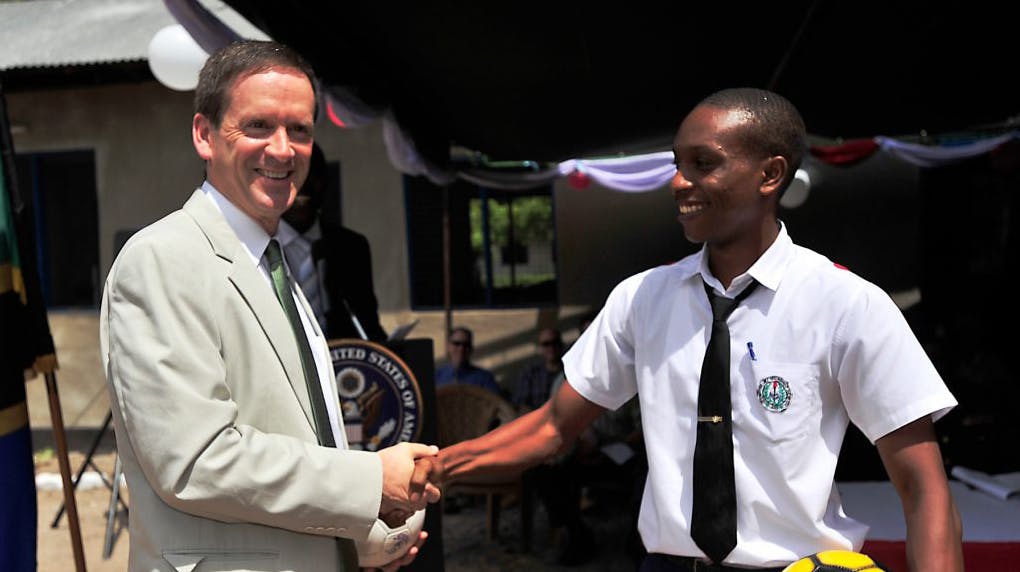Foreword: The Africa I Know
– Ambassador Mark A. Green
Drawing on his family ties to South Africa and his professional interactions with the continent including as US Ambassador to Tanzania, USAID administrator, and other global leadership roles, Green reflects on the Africa he knows.
When I’m introduced to audiences as an Africanist or, more often, as “an Africa guy,” people tend to chalk it up to nostalgia from my long, deep ties to the continent. I often tell people that everything I learned about development policy goes back to my days nearly 30 years ago as a teacher in a small village school in western Kenya.
My African roots and heritage go back even further. My father was born and raised in Queenstown, South Africa, and went to medical school at Johannesburg’s Witwatersrand University. My grandfather, great grandfather, and other relatives worked at newspapers in Queenstown and East London, South Africa. I was even baptized on a farm near Cathcart in South Africa’s Eastern Cape—but the Africa I know is about much more than family ties and nostalgia.
In my days in Congress in the 2000s, I worked closely with President George W. Bush’s team to forge legislation leading to the formation of the Millennium Challenge Corporation, and the President’s Emergency Plan for AIDS Relief—successful initiatives that changed the course of human history in many parts of Africa. Perhaps because of that work, President Bush asked me to serve as US Ambassador to Tanzania in 2007 and to host him the following year for the first official visit by a sitting US president. I also served as administrator of the US Agency for International Development where I continued to work with resourceful Africans across many different sectors.
I simply believe that in a time when there are so many cross-border and global challenges confronting us no solution will be achievable or sustainable unless young African minds have a seat at the table.
That is only a small part of the reason I am an Africa guy: I simply believe that in a time when there are so many cross-border and global challenges confronting us; a time when we need to develop new sources of energy; a time when we need to find new approaches to addressing the causes and consequences of sweeping human displacement; a time when we need to find ways to harness technology to improve food production and health outcomes; a time when we need to enhance conflict resolution and protect human freedom from those who would subjugate it to state control. None of these solutions will be achievable or sustainable unless young African minds have a seat at the table.
Those who see hope in Africa’s natural wealth—from oil and gas in places like Angola, Mozambique, and Nigeria, to critical mineral reserves in places like South Africa and the Democratic Republic of Congo. Others point to Africa’s strategic ports in places like Djibouti, the Cape of Good Hope, Dar es Salaam, Lagos and, of course, the Suez Canal. But the greatest natural wealth in the Africa I know lies in its people. Creative, ambitious, aspirational and, yes, impatient for their moment in the sun—a moment that the world keeps telling them is at hand. Many years ago, visitors to the continent would comment on the village children they saw who turned tin cans into toys and scrap metal into machines. Now young Africans have mobile phones in their hands and are building their own apps with remarkable results. As even more powerful technologies and technology teachers are increasingly within reach, what the International Monetary Fund Managing Director Kristalina Georgieva described as a “shock prone world” doesn’t seem so daunting.
The US and other donor nations have a crucial role to play. For the longest time, our programs have treated African nations as though they were hopeless and helpless. We spend less time listening to Africans to better understand their needs, priorities, and aspirations—and more time telling them what we are going to give them, whether they like it or not. More broadly, we haven’t worked with young African leaders to craft a vision for success. What do we all want the US-Africa relationship to look like 10 years from now? How can we be a better partner on this journey to self-reliance? In a brighter future, how can they move from being traditional aid recipients to partners to someday fellow donors?
In this issue of the Wilson Quarterly, we provide a glimpse of contemporary Africa—with its distinct countries, cultures, and creative forces—the Africa that has been growing and evolving while many of us were distractedly looking elsewhere.
In this issue of the Wilson Quarterly, we provide a glimpse of contemporary Africa—with its distinct countries, cultures, and creative forces—the Africa that has been growing and evolving while many of us were distractedly looking elsewhere. We hear from African leaders in trade and technology, trailblazers in the growing (and increasingly lucrative) creative sector, and respected advisors on governance and democracy. We also get a peek into the diversity of Africa’s population with stories from and about people doing extraordinary things. We see an Africa that is proactively finding solutions to their own challenges, and those that must be confronted around the globe.
Yes, I am an African guy and I do think back to those days in the village. But I do so because the dreams I saw in the big bright eyes of my students at Makhokho Secondary School were the same dreams I saw in my own children years later. There is power in those dreams—power that can lift lives and countries—and, I hope, the world.
Ambassador Mark A. Green (ret.) is president & CEO of the Wilson Center.
Cover photo: Mark A. Green, in 2008, as US ambassador to Tanzania, presents a student in Dar es Salaam with a soccer ball. (Photo courtesy US Navy)
